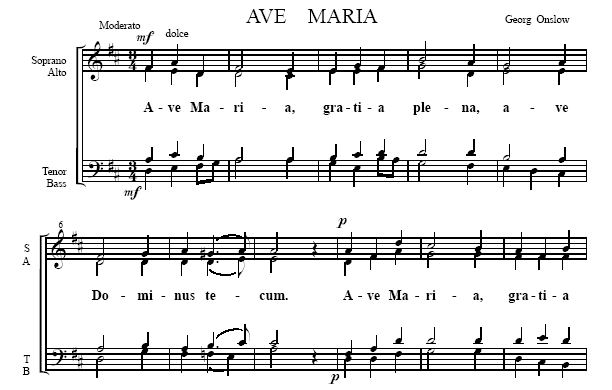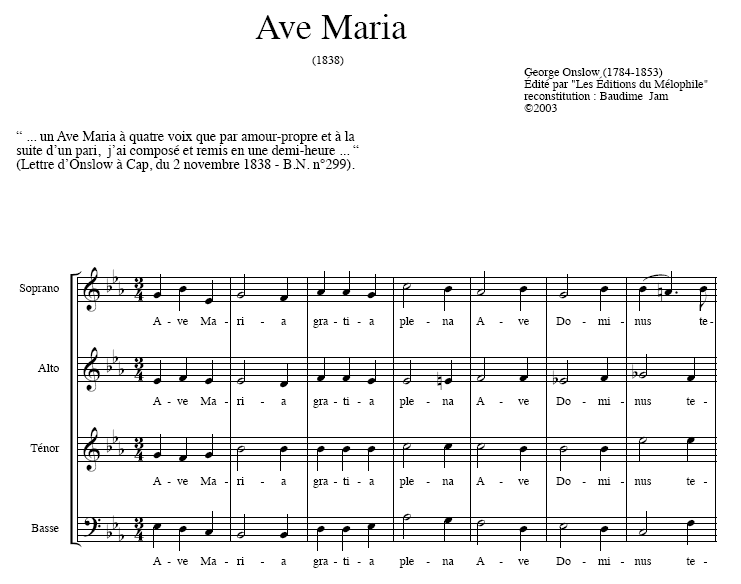Ave Maria
Composer: George Onslow (1784-1853), 1838

| Recording: not
available |
|
| Lyrics: |
|
|
A-ve Ma-ri-a, gra-ti-a ple-na, a-ve Do-mi-nus te-cum.
A-ve Ma-ri-a, gra-ti-a ple-na, a-ve Do-mi-nus te-cum.
be-ne-dic-ta tu
et be-ne-dic-tus fruc-tus ven-tris tu-i, Je-sus.
|
San-cta Ma-ri-a, Ma-ter De-i,
o-ra pro no-bis pec-ca-to-ri-bus,
nunc et in ho-ra mor-tis, in ho-ra mor-tis nos-trae.
A-men. A-men.
|
| Score: PDF file retrieved 2005
from www.choralistika.sandomierz.opoka.org.pl This website no
longer exists. |
|

|
| Free download available at IMSLP
http://imslp.org/wiki/Ave_Maria_(Onslow,_Georges) |
|

|

| Posted on YouTube: Not available at
this time. |
|
You could be
featured here!
If you (or your choir) perform this Ave Maria, make a video recording.
Post your video on YouTube, email me the page URL and I'll embed the video
in this page. |

You can also email me an MP3 for audio only. |

| Internet
references, biography information. |
|
http://en.wikipedia.org/wiki/George_Onslow_(composer) |
|
André George Louis Onslow (27 July
1784 – 3 October 1853) was an Anglo-French composer. He was widely
recognised as a gifted composer during his lifetime but is virtually
forgotten today.
Life
George Onslow was born in Clermont-Ferrand, the son of an English father,
Edward Onslow, and a French mother; his paternal grandfather was George
Onslow, 1st Earl of Onslow. As a young man he lived in London, where he
studied piano with Johann Baptist Cramer and also studied composition with
Dussek. His principal composition teacher was Anton Reicha with whom he
studied in Paris between 1807–1808; later he spent two years studying in
Vienna and was again a student of Reicha in the 1820s, when he wished to
broaden his technique to write opera. He died in Clermont-Ferrand.
Works
See also: List of compositions by George Onslow
His 36 string quartets and 34 string quintets were, during his own lifetime
and up to the end of the 19th century, held in the highest regard,
particularly in Germany, Austria and England, where he was regularly placed
in the front rank of composers. His work was admired by both Beethoven and
Schubert, the latter modelling his own 2-cello quintet (D.956) on those of
Onslow and not, as is so often claimed, on those of Boccherini. Robert
Schumann, perhaps the foremost music critic during the first part of the
19th century, regarded Onslow’s chamber music on a par with that of Mozart,
Haydn and Beethoven. Mendelssohn was also of this opinion. Publishers such
as Breitkopf & Härtel and Kistner were among many who competed to bring out
his works. Such was Onslow’s reputation that he was elected to succeed Luigi
Cherubini as Director of the prestigious Académie des beaux-arts, based on
the excellence of his chamber music and this, in an “Opera Mad France”,
which had little regard for chamber music. However, after the First World
War, his music, along with that of so many other fine composers, fell into
oblivion and up until 1984, the bicentennial of his birth, he remained
virtually unknown. Onslow’s writing was unique in that he was successfully
able to merge the drama of the opera into the chamber music idiom perfected
by the Vienna masters.
Besides his string quartets and quintets which were and remain his best
known and regarded works, he wrote 10 piano trios, three piano quintets, a
quintet for piano and winds, 2 sextets for winds and piano, a septet for
winds and piano, a nonet for strings & winds, 6 sonatas for violin and
piano, and one for cello and piano.
Beyond his chamber music, he composed four symphonies, four operas
(including at least one, Le Colporteur, themes from which formed the subject
of fantasies by other composers, like Friedrich Kuhlau's for flute and
piano), several works for piano alone as well as five vocal works. His
second symphony (D minor, opus 42) shows some commonality of style with
Beethoven, particularly in the dramatic first movement, and with Schubert.
|

Please notify us of any
broken/defective links

Page last modified:
April 03, 2013
Return to my homepage:
www.avemariasongs.org

|
![]()